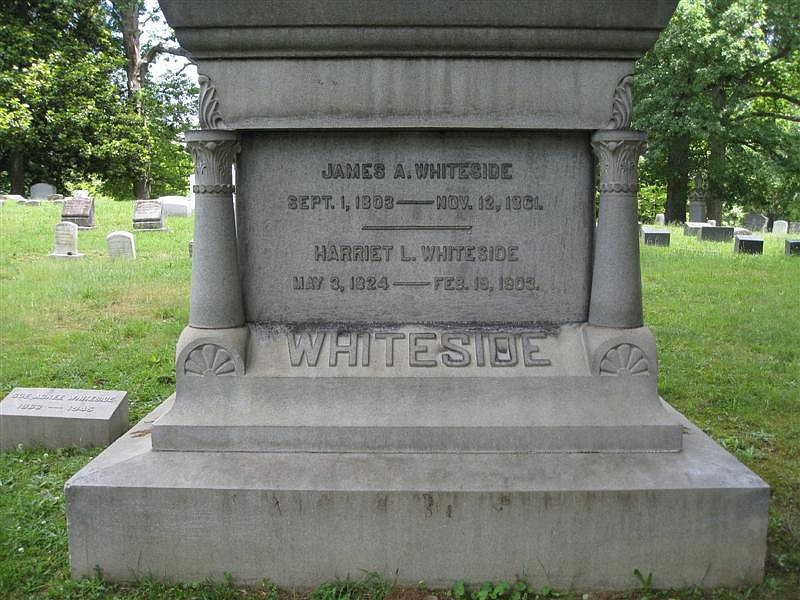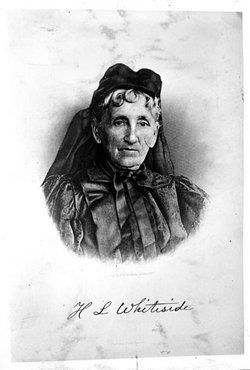(Editor's note: First in a Women's History Month series)
A casual search of regional history often discloses the Whiteside name. James Anderson Whiteside, the grandson of Irish immigrants, was reared in Overton and Bledsoe counties, educated in White County, gained a certain fame as an attorney in Davidson County and, by 1838, had moved to Chattanooga Valley with his first wife and five children.
He quickly became a leading citizen with extensive investments in Lookout Mountain land holdings and area business endeavors, including the critical element for Chattanooga's success, the railroads. In 1844, Whiteside, now a widower, married a second time. Land records reveal references to his homes, a wagon road from Chattanooga Valley to the summit of Lookout Mountain named the Whiteside Pike and the Lookout Mountain Hotel. While amassing his financial empire, James Whiteside also served in the Tennessee legislature, donated land for St. Paul's Episcopal Church, and later served as vice president of the Chattanooga and St. Louis Railroad. His death in 1861 threatened the Whiteside empire, but into the void stepped his widow.
In the decades between 1861 and her death in 1903, Harriet Lenora Straw Whiteside established herself as a leading citizen of the region and was heralded as the most successful and wealthiest woman in Tennessee.
The Chattanooga News announcement of her death [Feb. 21] and subsequent articles over the next week paid tribute to the late Mrs. Whiteside. "In her death, one of the finest brains and one of the ablest minds which has aided and assisted in the development of Chattanooga has gone to rest" was followed by "All who know anything about it can testify that she has never lost her grip on the mountain to which the mountain is indebted for the present prospect of making the Inn a center of business and of culture, refinement, health and pleasure."
In addition to the tributes to her business savvy, Mrs. Whiteside was also proclaimed to have been "a tigress fighting for her young. She brought to her assistance the highest degree of culture, education, polish, refinement, never forgot that she was a lady She fought for the reputation of that grand man, her husband she whipped the bar and the courts who knew James A. Whiteside gave her all she asked." One newspaper account ended with the pronouncement: "If there are monuments in Heaven raised to mothers, this grand woman will have one there erected to the faithful wife and devoted mother "
How had Mrs. Whiteside contributed to the growth of Lookout Mountain and the region and come to be held in such high esteem? Why was she, in almost the same breath, described as a lady of culture and a tigress who had accumulated many enemies and detractors? Why would her most ardent adversary in countless lawsuits, Col. Tomlinson Fort, defend her actions?
Harriet Whiteside was a woman with strong intellectual rather than domestic interests. As Col. Fort also recalled in an interview, "She was highly educated, a splendid conversationalist, queenly in her style, capable of filling any station in life to which she might be called, and, with it all, she was a beautiful woman." With her husband's death in 1861, the 36-year-old Harriet found herself charged with control of her husband's land, railroad stock and coal mines, while only receiving a child's share of the estate, equally divided with the 12 children from his two marriages.
She moved quickly, paying debts against the estate and purchasing new holdings with Confederate dollars. In less than two years, both Confederate and Union forces would be moving through Chattanooga, and both armies would, at different times, make use of the Lookout Mountain Hotel. Despite her oath of loyalty given on Sept. 22, 1863, Mrs. Whiteside was deported north in the spring of 1864, given only 24 hours to prepare for her trip.
Quickly raising and secreting away $3,000, Mrs. Whiteside and her minor children traveled to Nashville and then to Louisville, where they were detained in a stockade prison for two weeks before being sent farther north to Ohio. She would not see Chattanooga again until the fall of 1865, when she would find her home occupied by Union officers. The Whiteside family would be allowed the use of one room and her movements limited by the military. But Harriet had a plan
And, the story will continue next week.
Linda Moss Mines, the Chattanooga and Hamilton County historian, served on the Tennessee 100 Woman Committee and is regent, Chief John Ross Chapter, NSDAR.

